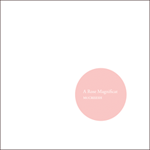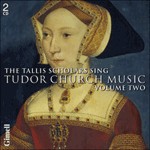The Magnificat is conservative: perhaps an inevitable consequence of White’s decision to follow a tradition of settings of this canticle which had originally evolved from John Taverner’s six-part version. White copied Taverner (as did Parsons and Mundy in their Magnificat settings) in using a basic choir of treble, mean, two altos, tenor and bass, which is sub-divided for some of the verses but includes a triple gimell of two trebles, two means and two basses at ‘Esurientes’. (Much of the treble part, as at ‘Esurientes’, is missing and has been reconstructed by Sally Dunkley.) Between the three magnificently spacious full-choir statements (‘Et exsultavit’, ‘Fecit potentiam’, and ‘et in saecula’) the ebb and flow of trios and quartets is carefully handled. The influence of Taverner’s mature style is audible at, for example, ‘Sicut locutus est’, where the plainchant appears in the mean, with the two alto and tenor parts intertwining beneath it.
from notes by Peter Phillips © 1995
Le Magnificat est «conservateur», résultat peut-être inéluctable du fait que White choisit de suivre une tradition de mises en musique de ce cantique dont la version à six voix de John Taverner était à l’origine. White imita Taverner (comme le firent Parsons et Mundy dans leurs mises en musique du Magnificat) en employant un choeur constitué à la base de TrMAATB (treble, mean, altus I et II, tenor et basse), qui se subdivise pour certains versets mais comporte un triple gimell pour deux trebles, deux means et deux basses sur «Esurientes». (La partie de treble, comme sur «Esurientes», a partiellement disparu et a été reconstituée par Sally Dunkley.) Entre les trois sections avec choeur complet, d’une magnifique ampleur («Et exsultavit», «Fecit potentiam» et «et in saecula»), le flux et le reflux des trios et quatuors font l’objet d’un usage attentif. On perçoit l’influence du style abouti de Taverner sur, par exemple, «Sicut locutus est», où le cantus planus (mélodie de plain-chant) apparaît dans la partie de mean avec, en-dessous, les voix d’altus I et II et de tenorqui s’entrelacent.
extrait des notes rédigées par Peter Phillips © 1995
Français: Myrna F Denis/Gimell
Das Magnificat ist dies wahrscheinlich die unvermeidliche Konsequenz der Entscheidung Whites, hinsichtlich der Vertonung dieses Textes einer gewissen Tradition zu folgen, die ursprünglich von John Taverners sechsstimmiger Magnificat-Vertonung ihren Ausgang nahm. White folgte Taverner, ebenso wie Parsons und Mundy bei ihren Vertonungen, indem er als Basis einen Chor bestehend aus Sopran, Mean, zwei Altstimmen, Tenor und Baß verwendet und diesen bei einigen Versen aufteilt, wobei im “Esurientes” auch eine Passage im dreifachen Gimell-Satz mit zwei Sopranen, zwei Means und zwei Baßstimmen eingearbeitet ist. Ein beträchtlicher Teil der Sopranstimme, auch im “Esurientes”, ist verloren und wurde von Sally Dunkley rekonstruiert. Das Gleichgewicht der beeindruckend weiträumig gesetzten vollchörigen Abschnitte (“Et exsultavit”, “Fecit potentiam” und “et in saecula”) und der drei- und vierstimmigen Teile wird sorgfältig gewahrt. Taverners reifer Stil wird etwa beim “Sicut locutus est” hörbar, wenn die gregorianische Melodie im Mean greifbar wird und die zwei Alt- und Tenorstimmen darunter ineinander verwoben werden.
aus dem Begleittext von Peter Phillips © 1995
Deutsch: Gerd Hüttenhofer


 A Rose Magnificat
A Rose Magnificat The Tallis Scholars sing Tudor Church Music, Vol. 2
The Tallis Scholars sing Tudor Church Music, Vol. 2
